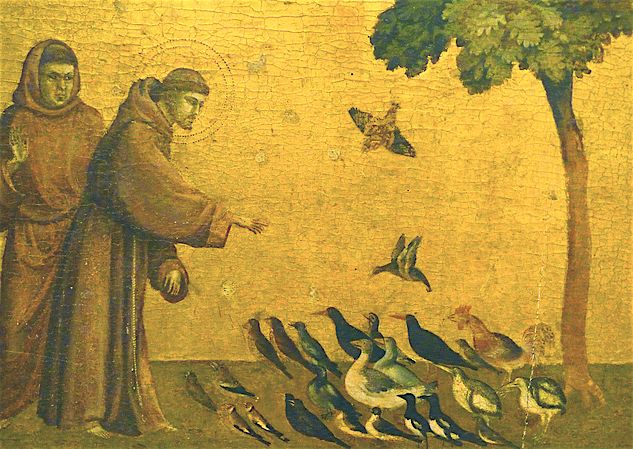For the Love of All: Ahimsa in Nonviolence and Radical Ecology
by Saskia van Goelst Meijer

St. Francis Preaching to the Birds; fresco by Giotto, courtesy wikiart.org
There is a difference here between proactive non-harming
and “doing nothing.” — Irina Aristarkhova (2012)
Our world is experiencing an ever-growing ecological crisis, which makes it necessary for humanity to reshape the way it is dealing with the planet. Grave challenges for the future of humanity and the earth as a whole have emerged as a result of ecological and economic conduct over the past few centuries. According to some, the environmental crisis is intertwined with other crises (financial, social, political), which has led both scholars and activists to call for a fundamental change in the global paradigm. Where socio-political change is concerned, part of this paradigm change has been attempted through nonviolence. Pioneered as a method in the early 20th century by Mohandas Gandhi for addressing injustice, it has since been taken up by many more individuals and organisations around the world. Nonviolence practices and notions can also be found in certain streams of ecology. One central element in the method of nonviolence is ahimsa, ‘the absence of the intention to do harm.’ In this article I will explore both ahimsa and radical ecology, to both explain the role and significance of ahimsa in nonviolence and to see if and how the two notions can clarify and supplement each other.
Since the second half of the twentieth century, concern for the state of the environment has grown exponentially. Humanity is increasingly confronted with the growing negative ecological effects of its actions. Various forms of pollution have proved very hard to clean up (Conway & Pretty, 2013; Metcalfe & Derwent, 2005; Meuser, 2010; Whitacre, 2007), and the depletion of resources (Kruger, 2013), loss of biodiversity (Dronamraju, 2008; Naeem, Bunker,& Hector, 2009; O’Riordan & Stoll-Kleemann, 2002), global warming, climate change and rising ocean levels (Maslin, 2004; Metcalfe & Derwent, 2005; Scott-Cato & Hillier, 2010; Shiva, 2008) can’t reasonably be overlooked anymore. This has led to the emergence of many global environmental organizations (Curran, 2006; Haigh, 2002; Merchant, 2005; Shiva, 1988;L. Williams, Roberts, & McIntosh, 2011), the emergence of green political parties throughout the world (Bomberg, 1998; Goodin, 2013) and multilateral initiatives to take action. But the views on how to address these problems vary widely (Bomberg, 1998; Goodin, 2013; Rogelj et al., 2010; Wulfhorst & Haugestad, 2006; Zimmerman, 1997).
In the view of some, solving environmental problems is seen as incompatible with solving human social problems, of which there are also many (Tanner & Horn-Phathanothai, 2014). Solving global problems then becomes a choice between addressing social issues (famine, war, disease) or ecological problems. However, in other views both kinds of problems are seen as deeply interrelated and it is argued that real solutions can only be created through a comprehensive global paradigm shift in which humanity transforms the way it deals with the planet and all its inhabitants (Bronner, 2002; Merchant, 2005; Zimmerman, 1997). Radical Ecology is one stream of thought that takes the latter view.
Read the pdf of the complete article here: For the Love of All
EDITOR’S NOTE: Saskia van Goelst Meijer is Assistant Professor Spiritual Counseling at University of Humanistic Studies, Utrecht, Netherlands. Her PhD thesis was Profound Revolution: Towards an Integrated Understanding of Contemporary Nonviolence, Utrecht: University of Humanistic Studies, 2015.




